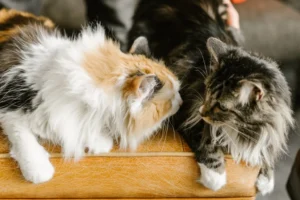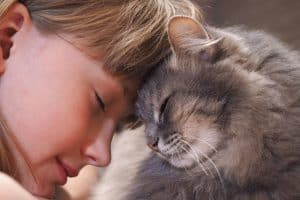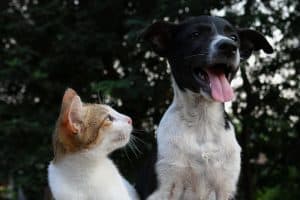Cats have long been companions to humans, with their independent and mysterious nature captivating many. Despite this close relationship, cats are not fully domesticated animals. But why is that?
Evolution of Cats
Wild at heart, cats have a long history of independence that still influences their behavior today. Dating back to ancient Egypt, where they were worshipped and revered, cats have always held a certain mystique that set them apart from other domesticated animals. Unlike dogs, which have been selectively bred for centuries to work alongside humans, cats have maintained much of their ancestral traits.
Through centuries of evolution, cats have honed their hunting skills, agility, and stealth to survive in the wild. This survival instinct is deeply ingrained in their DNA, making them natural-born hunters and explorers. Even today, domestic cats retain these instincts, often displaying behaviors like stalking, pouncing, and territorial marking.
One key factor in the semi-wild nature of cats is their ability to thrive independently, even without human intervention. Unlike dogs that rely heavily on humans for food and shelter, cats are proficient hunters that can fend for themselves if needed. This self-sufficiency is a testament to their wild roots and sets them apart from fully domesticated animals.
Overall, the evolution of cats has shaped them into the enigmatic creatures we know and love today. Their independence and hunting prowess stem from centuries of survival in the wild, making them a unique and fascinating species to coexist with.
Independent Behavior
When it comes to understanding cats, their independent behavior is a defining characteristic that sets them apart from fully domesticated animals. Unlike dogs that thrive on companionship and constant interaction, cats are known for their aloof and solitary nature.
One of the reasons why cats are not fully domesticated is their strong sense of self-reliance. They have the innate ability to hunt, groom, and establish territories on their own, reflecting their wild ancestry. This independence means that cats do not rely heavily on humans for survival, unlike other domesticated animals.
Additionally, cats exhibit a wide range of instinctual behaviors that contribute to their semi-wild nature. From kneading and purring to spraying and scratching, these behaviors serve essential purposes in the wild but can be challenging for pet owners to manage. Understanding and respecting these natural instincts is crucial in creating a harmonious relationship with your feline friend.
In conclusion, cats straddle the line between wild and domestic, maintaining a level of independence and self-sufficiency that is deeply rooted in their DNA. Embracing and appreciating their unique behaviors is key to fostering a strong bond with these captivating creatures.
Lack of Selective Breeding
Contrary to popular belief, cats are not fully domesticated like dogs. One key reason for this lies in the lack of selective breeding. Unlike dogs, who have been selectively bred for various traits over thousands of years, including size, temperament, and job-specific skills, cats have not undergone the same level of intense breeding. This has led to a natural predisposition in cats to be more independent and less reliant on humans for survival, making them exhibit behaviors more typical of their wild ancestors. As a result, cats retain a sense of autonomy that dogs may lack, contributing to their less domesticated nature.
Feline Communication
When it comes to feline communication, understanding how cats interact with humans and other animals is crucial in explaining their level of domesticity. Cats communicate through a complex system of vocalizations, body language, and scent marking. Unlike dogs, who have been bred to be more attuned to human cues and commands, cats tend to rely more on subtle signals and cues to express their needs and emotions. This can sometimes be misinterpreted by humans as aloofness or independence, when in fact, cats are simply communicating in a way that is natural to them. Building a strong bond with your cat involves learning to interpret and respond to their unique communication style, which can help bridge the gap between their wild instincts and their life as a pet.
Additional Unique Insight: Understanding a cat’s communication style can help improve the bond between you and your feline friend. Recognizing their cues for play, hunger, or affection can foster a deeper connection and mutual understanding. By paying attention to your cat’s body language and vocalizations, you can build a stronger relationship based on clear communication and trust.
- Purring: Indicates contentment or comfort.
- Meowing: Can signal a variety of needs, from hunger to wanting attention.
- Kneading: Reflects comfort and relaxation.
- Tail Position: A tucked tail can indicate fear, while an upright tail signals confidence.
Remember, cats may not be as fully domesticated as dogs, but with patience and understanding, you can create a harmonious and loving relationship with your feline companion.
Hunting Instincts
Cats’ hunting instincts play a significant role in why they are not fully domesticated. Even if your feline friend has never had to catch a mouse for dinner, those natural instincts remain strong. This can lead to behaviors like stalking, pouncing, and even bringing you “presents” that may not be appreciated. It’s essential to provide plenty of interactive toys to satisfy these instincts and prevent them from seeking out less desirable prey in your home.
Territorial Nature
Cats’ territorial nature is another factor that hinders complete domestication. Felines are known for marking their territory with scent glands on their faces and paws, making them prone to defending their space. To help your cat feel more secure in your home, create vertical spaces like cat trees or shelves for climbing. Providing multiple litter boxes and separate feeding stations can also reduce territory-related stress and promote harmonious living.
Unique Insight: One fascinating aspect of cats’ territorial behavior is their inclination to form close bonds with their territory rather than with specific individuals. This can make them less reliant on human companionship and perhaps more independent compared to fully domesticated animals.
- Provide plenty of vertical spaces for your cat to climb and perch on, creating additional territory for them.
- Offer multiple litter boxes in different areas of your home to accommodate your cat’s territorial marking behavior and reduce stress.
- Establish separate feeding stations to prevent territorial disputes over food and promote a peaceful environment for all your feline friends.
Hybrid Breeds
Curious about why some cats seem to have a bit of wild spark in them? Well, the rise of hybrid breeds might hold the answer. These unique feline combinations, like the Bengal or Savannah cats, introduce wild genes into the mix, creating a blend of domestic and wild traits. These hybrids can exhibit behaviors more akin to their wild ancestors, showcasing a side of feline nature that resists complete domestication. With their striking appearances and spirited personalities, hybrid breeds challenge the boundaries of domesticity in cats, offering a glimpse into the complex world of feline genetics and behavior.
Genetic Factors
When it comes to unraveling the mystery of why cats remain only partially domesticated, genetic factors play a crucial role. Through centuries of evolution, cats have retained genetic traits that make them more independent and less reliant on human care compared to fully domesticated animals like dogs. This inherent self-reliance and strong survival instinct can sometimes lead cats to exhibit behaviors that seem more wild than domestic. Additionally, certain genetic markers linked to territorial behavior and hunting prowess contribute to a cat’s semi-wild nature, making them elusive creatures that defy full domestication.
Additional Insight:
Here are some genetic components that contribute to a cat’s semi-wild nature: 1. Instinctual Hunting Abilities: Cats possess innate hunting skills passed down through generations, allowing them to survive in the wild even when domesticated. 2. Territorial Behavior: Cats have a strong sense of territory, stemming from their wild ancestors, which can make them more aloof and independent compared to fully domesticated animals. 3. Single-minded Focus: Cats exhibit a laser-like focus when hunting or exploring, showcasing a primal instinct that harks back to their wild roots. By understanding these genetic factors, we gain insight into why cats remain only partially domesticated despite living alongside humans for centuries.
Cultural Differences
Cats are not fully domesticated due to cultural differences influencing the way they are perceived and treated around the world. In some cultures, cats are revered and considered valuable companions, leading to a higher level of domestication. However, in other cultures, cats are seen as more independent creatures and are not as heavily influenced by human interaction. This divergence in cultural attitudes plays a significant role in the semi-domestic nature of cats globally.
Interesting Fact: Ancient Egypt Connection
The special relationship between cats and Ancient Egyptians sheds light on why cats are not fully domesticated. In ancient Egypt, cats were revered as sacred animals, often worshipped as symbols of grace and poise. This elevated status granted them a level of independence and respect that transcended traditional domestication. The bond between cats and Ancient Egyptians set a precedent for the semi-domestic nature of cats, highlighting their unique place in history and culture.
- Cats in Ancient Egypt were believed to have protective qualities, guarding homes and families against evil spirits.
- The significant role of cats in Egyptian society contributed to their semi-domestic status, as they were treated with a level of respect and autonomy not typically seen in fully domesticated animals.
Unique Behavior Traits
Cats possess a unique set of behaviors that differentiate them from other fully domesticated animals. One intriguing trait is their independent nature, a characteristic ingrained in their DNA from their wild ancestors. Unlike dogs, who have been selectively bred for thousands of years to work alongside humans, cats maintain a sense of self-reliance and autonomy. This independence can sometimes be mistaken for aloofness, but it’s simply a natural instinct for survival. Moreover, cats are skilled hunters, with a strong predatory drive that influences their behavior. They exhibit behaviors like stalking, pouncing, and playing with their prey, even if it’s just a toy. These instincts are deeply rooted and contribute to their semi-wild nature, making them fascinating and enigmatic creatures to coexist with.
By understanding these unique behavior traits, we can appreciate the depth and complexity of our feline friends. Their independence, hunting instincts, and mysterious nature all play a part in why cats are not fully domesticated animals. So next time your cat exhibits these behaviors, remember it’s just their innate instincts shining through.
Factors Contributing to Semi-Domestication
Selective Breeding : Unlike dogs that have undergone extensive breeding to serve specific purposes, cats have not been subjected to the same level of domestication. Their genetics still closely resemble their wild ancestors, contributing to their semi-domesticated nature.
Wild Origins : Cats are descended from African wildcats, which were solitary hunters. This lineage has influenced their independence and self-sufficiency, traits that remain prominent in modern house cats.
Territorial Instincts : Cats are territorial animals by nature, marking their territory with scent glands on their cheeks and paw pads. This territorial behavior is a remnant of their wild ancestry, contributing to their semi-domestication status.
Limited Socialization : While cats can form strong bonds with their human companions, they are less inclined to socialize with unfamiliar animals or people. This limited socialization is another factor that sets them apart from fully domesticated animals.
Reproductive Patterns : Cats reproduce more freely than fully domesticated animals, with feral cat populations thriving in urban environments worldwide. This reproductive freedom contributes to their semi-wild status and prevents complete domestication.
By considering these factors, we can better grasp why cats are not fully domesticated and appreciate the intricate balance between their wild instincts and their relationships with humans.
Alex, a passionate animal lover, has experience in training and understanding animal behavior. As a proud pet parent to two dogs and three cats, he founded AnimalReport.net to share insights from animal experts and expand his knowledge of the animal kingdom.









